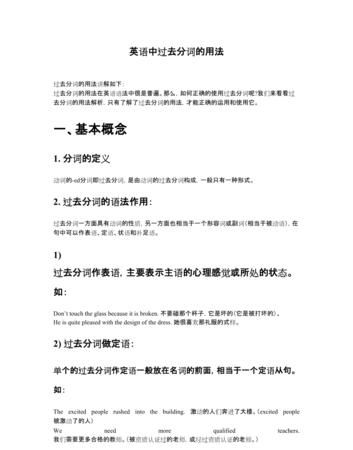本文目录
过去分词的用法
英语分词用法
分词用法详析
分词也是一种限定动词,分为现在分词和过去分词。它保留着动词的若干特征,又具有形容词、副词的特征。分词有时态和语态变化,又带有宾语并能被状语修饰。分词在句中主要作定语、状语用,作表语也十分普遍。
一、分词的形式
语态
时态
主动语态
被动语态
一般式
doing
being done
完成式
having done
having been done
其否定形式是在doing之后加上not。
二、分词的作用
分词在句中可作定语、表语、状语、补足语等。
1、作定语
分词作定语有两种形式。它可以放在被修饰的名词之前,称为前置定语。有的放在被修饰的名词之后,称为后置定语。
(1)前置定语
He is a promising young man. 他是一个有前途的年轻人。
Make less noise. There’s a sleeping child. 不要出太大声音,有个孩子在睡觉。
We only sell used books. 我们只卖用过的书。
(2)后置定语
The young man sitting between John and Mary is the editor of the campus newspaper. 坐在约翰和玛丽之间的那个年轻小伙子是校园报的编辑。
The bridge built last month needs repairing. 上个月建造的那座桥需要修理。
(3)过去分词作定语有的既可前置也可后置。如:
All the broken windows have been repaired. 所有坏了的窗户已经修理好了。
All the windows broken have been repaired.
(4)分词短语作定语必须置于被修饰词之后,相当于一个定语从句。如:
Those wishing to join this club should sign here. 想加入本俱乐部的人在这里签名。 (=Those who wish to join the club should sign here.)
The man, having been disturbed so badly, almost lost his memory. 由于被严重困扰,这个人几乎失去了
记忆
。 (The man, who had been disturbed so badly, almost lost his memory.)
(4)完成体的分词一般不作定语,若要表达完成意义最好用定语从句。如:
我们一般不说:The girl having won the race is my deskmate.
而常这样说:The girl who has won the race is my deskmate.
(5)非限定性的完成体作定语或如果分词所修饰的词是泛指则没有这个限制。如:
Anyone having passed the test has got a prize. 任何通过
考试
的人都能得到一份奖品。
Charlie, having lived in Paris for years, decided to return to London. 在巴黎呆过多年,查理决定重返伦敦。
(6)过去分词作定语在意义上有两种可能:表示被动和完成,只表完成。如:
the question discussed yesterday 昨天讨论的问题 (既表示被动也表示完成)
the fallen leaves 落下的树叶 (只表示完成,不表示被动)
在
英语
中只表完成不表被动的往往是一些不及物动词的过去分词,常见的有:
the changed situation, a newly returned sudent等。
2、作表语
分词作表语表示主语的某种性质或状态。如:
The shops have remained shut for a week. 这家商店关门一周了。
What you said is really inspiring. 你所说的真令从鼓舞。
3、作宾语补足语
I oftentimes hear a girl singing downstairs. 我有时听到楼下有一个小姑娘在唱歌。
I find some students in this school often punished by the teachers. 我发现这所学校的学生经常被老师惩罚。
用分词作宾语补足语的动词请参阅《句法篇-句子的类型》部分。
4、作状语
分词在句中作状语,可以表示各种不同的语义内容。它可以表示时间、原因、让步、结果、方式、条件等。如:
(1)表示时间
Arriving in Paris, I lost my way. 到了巴黎,我迷了路。
The hunter walked slowly in the forest, followed by his wolf-dog. 猎人在森林里慢慢地走着,后面跟着一只狼狗。
表示与主句中谓语动词同时性的现在分词强调时间意义时,分词前可以加上while, when等从属连接词,但as没有这种用法。如:
Don’t talk while having dinner. 吃饭时不要说话。
When crossing the street, do be careful. 过马路时要小心。
(2)表示原因
表示原因的分词短语一般置于句首。
Having lived in London for years, I almost know every place quite well. 在伦敦住过多年,我几乎对每个地方都很熟悉。
Seriously injured, he had to be taken to hospital. 由于伤得严重,只好把他送往医院。
(3)表示结果
The fire lasted nearly a month, leaving nothing valuable. 大火持续了近一个月,几乎没剩下什么有用的东西。
Football is played in more than 80 countries, making it a popular sport. 80多个国家都踢足球,因此足球成了一种很流行的运动。
(4)表示方式
I stood by the door, not daring to say a word. 我站在门旁,不敢说一句话。
(5)表示条件
United, we stand; divided, we fall. 联合起来我们就能站立,分裂我们必然倒下。
Being more careful, you can make fewer mistakes. 如果你更细心,你会犯更少的错误。
强调条件时,可以在前面加上unless, once等。如:
You shouldn’t come in unless asked to. 不让你进来你不准进来。
Once losing this chance, you can’t easily find it. 一旦失去这次机会你就很难找回。
二、分词的独立主格结构
分词短语作状语时,其逻辑主语就是句子的主语,否则,就必须在分词前另加上自己的逻辑主语(名词或主格代词)的这个结构叫独立主格结构或分词的复合结构。
1、独立主格结构常放在句首。表示时间、条件、原因时,其作用分别相当于个时间、条件、原因状语从名句。表示伴随方式时,相当于一个并列句。如:
Supper finished (=After supper was finished), we started to discuss the picnic. 吃完晚饭,我们开始讨论野餐的事。
All the tickets having been sold out (=As all the tickets having been sold out), we had to wait for the next week’s show. 所有的票都卖出去了,我们只好等着看下周的演出。
2、表示独立主格结构中的being常省略。如:
The football match (being) over, crowds of people poured out into the steet. 足球赛五结束,从群便涌到大街上。
Nobody (being) in, I didn’t enter the hall. 里面没有人,我没进大厅。
3、表示伴随方式的独立主格结构,有时可用“with+宾语+宾语补足语”的结构来替换。如:
He lay there thinking, his hands behind his head (with his hands behind his head). 他双手放在头下,躺在那里思考着。
The river looks more beautiful, flowers and grass growing on both sides(=with flowers and grass growing on both sides). 这条河看上去更加漂亮,因为两岸长满了鲜花和绿草。
with+宾语+宾语补足语的结构是
英语
中常见常用的结构,其宾语补足语可以是现在分词、过去分词、不定式、形容词、副词、介词短语等,在句中可作定语,也可作状语,表示原因、方式等。如:
The children looked at us, with their eyes opening wide. 孩子们眼睛睁得大大地看着我。
I would miss the train, with no one to wake me up. 没人叫我,我会错过火车的。
The river with grass and flowers on both sides runs through our schoolyard. 这条两河两岸长满鲜花和绿草正从我们校园穿过。
With the examinations over, we had a long time to rest.
考试
结束了,我们有一段长长的时间可以休息。
4、有些惯用的分词短语在句里可以没有逻辑上的主语而独立存在,它们往往作为句子的独立成分来修饰全句。如:
generally/strictly/roughly/broadly/narrowly speaking, judging from/by, considering, supposing, providing, provided等。如:
Talking of the computer, I like it very much. 谈到电脑,我非常喜欢。
Considering the time, we have decided to start early tomorrow morning.
考试
到时间,我们已经决定明早一早出发。
be 动词+过去分词:被动语态
The trees were planted on the hill . ( were planted )
have /has+过去分词:现在完成时
Have you finished your homework?(have finished )
had+过去分词:过去完成时
He said that he had been there twice. (had been )
名词+过去分词:过去分词做后置定语
The girl named Mary is my classmate. ( The girl named )
过去分词(短语)作定语
We should pay attention to our spoken English.
单个过去分词作定语常放在它所修饰的名词之
前, 和它所修饰的名词存在动宾(被动)关系。
This is one of the schools built in 1980.
=This is one of the schools which were built in 1980
过去分词短语常放在它所修饰的名词之后,与
被修饰的名词之间存在动宾关系,相当于一个
定语从句,但是更简洁。
1) — I ’m very thirsty.
— You’d better drink some ___ water.
A. boiling B. boil C. boiled D. to be boiled
过去分词(短语)作表语
The children were satisfied with his explanation
She looked worried.
过去分词(短语)用在系动词之后作表语,和句子主语之间存在动宾关系。
1. The rooms are ____, so you can’t move in.
A. painted B. painting
C. being painted D. to be painted
过去分词作表语和被动语态的区别
This river is polluted.(过去分词作表语,表状态)
译:这条河被污染了
This river was polluted by the chemical plant.
(过去分词构成被动语态,表动作)
译:这条河是被那家化工厂给污染的。
过去分词作表语,表状态,相当于一个形容词;在被动语态中,过去分词表动作,常由by引出动作的发出者。
The windows are closed
The windows were closed by Jack
过去分词(短语)作宾语补足语
I found the small town changed a lot.(表动作已完成)
He wants the letter typed right away.(动宾关系)
过去分词(短语)在句子中作宾语补足语表示动作已完成,
或和宾语存在动宾关系。这类句子的谓语动词通常是表示
“感知”(如see, hear, feel, watch, notice, find等)、
“意愿”(如want, wish, expect, 等) 的动词,
或是使役动词(如make, have, keep, get 等)。
1.We saw the thief_________ (catch) by the police.
过去分词(短语)作状语
过去分词(短语)作状语,修饰谓语,常常表示时间、条件、原因、让步、伴随情况等,相当于对应的状语从句。它和主句的主语存在动宾关系。
a、表示时间
Seen from space, the earth looks blue.
When it is seen from space, the earth looks blue.
b、表示条件
Kept in refrigerator, these vegetables will remain
fresh.
If they are kept in refrigerator, these vegetables will remain fresh.
c、表示原因
Deeply moved by the movie, the girls began to cry.
As they were deeply moved by the movie, the girls began to cry.
d、表示伴随情况
She walked out of the house, followed by her daughter.
She walked out of the house, and was followed by her
daughter.
e、表示让步
Beaten by the enemy, he refused to let out the secret.
Although he was beaten by the enemy, he refused to
let out the secret.
1._____ a reply, he decided to write again.
A. Not receiving B. Receiving not
C. Not having received D. Having not received
2. ____in her new skirt ,she tried to make herself ____at the party .
A. Dressed; noticed B. Dressing; noticed
C. Dressed; noticing D. Dressing; being noticing
3. ____ better attention , the vegetables could have grown better
A. Giving B. Given C. Give D. To give

过去分词的用法
一、英语过去分词通常表示的是及物动词的一种变化形式;
1、常用于完成时,形成固定搭配;
如:He has done his homework.他完成了他的家庭作业。
done是do的过去分词形式,在本句中表示“他已经完成了他的家庭作业。”
2、在句中作表语,与句子的主语是被动关系,表示主语的状态,不但表示被动,还强调已完成了;
如:The glass is broken.玻璃杯破了。
broken是break的过去分词形式,在本句中表示主语glass的状态,强调被打破,且已成事实。
3、在句中做定语,常用于一般现在时或过去时,既表被动又表完成;
如:We must adapt our thinking to the changed conditions. 我们必须使我们的思想适应改变了的情况。
changed是changed的过去分词形式,作conditions的定语,修饰conditions。
二、英语中,有些不及物动词也有过去分词,在句中作表语,与句子的主语是主动关系,表示主语的状态,同样强调动作的完成。
如:He is retired. 他已退休。
retired是retire的过去分词形式,表示主语He的状态。

过去分词放在开头是什么用法
过去分词用法透视
过去分词一般表示完成的和被动的动作,在句子中可以用作定语、表语、宾语和状语,但不能单独构成谓语,在历届高考试题中,过去分词都是考查的重点,现结合历届高考试题,对其用法作一简要分析。
一、 作定语。 单个的过去分词作定语一般放在名词的前面,如果是过去分词短语,要放在名词的后面。过去分词作定语是高考考查的重点。如:
1.Linda worked for the Minnesota Manufacturing and Mining Company, _______ as 3M. (2004浙江)
A. knowing B. known C. being known D. to be known
析:答案B。过去分词known短语作Minnesota Manufacturing and Mining Company的定语,表示被动。
2.The first textbooks for teaching English as a foreign Language came out in the
16th century. (NMET94)
A. having written B. to be written C. being written D. written
析:该题旨在考查分词作定语的用法。句中的the first textbooks与write之间是被动关系,而且write 所表示的动作已经完成,故应排除A、B、C三个选项,Written相当于that were written。
3.The Olympic Games, in 776B.C, did not include women players until 1912. (NMET97)
A. first playing B. to be first played C. first played D. to be playing
析:此题是考查过去分词作非限制性定语的用法.句中The Olympic Games与play之间是被动关系,故排除A、D 项。B项是不定式的被动式,表示“未来”,故也排除。因此,应该选C项,它相当于一个非限制性定语从句which were first played.
4.The computer center, last year, is very popular among the students in this school .(MET93)
A. open B. opening C. having opened D. opened
析:此题也是考查过去分词作非限制性定语,opened与先行词the computer center之间是被动关系,相当于which was opened last year. 既“去年开业的”。
二、作宾语补足语。如:
5.You should understand the traffic rule by now. You’ve had it _______ often enough. (2005年天津)
A. explaining B. to explain C. explain D. explained
析:答案D。explained短语作宾补,表示交通规则已被解释的足够多了。
6.The speaker raised his voice but still couldn’t make himself_________. (MET’91)
A. hear B. to hear C. hearing D. heard
析:此题正确答案为D。make sb. do sth.和 make sb. done都是固定短语,但此句的意思是:heard。
7.The managers discussed the plan that they would like to see______ the near year. (NMET’2000)
A. carry out B. carrying out C. carried out D. to carry out
析:此题考查过去分词短语作宾语补足语的用法。四个选项均为短语动词carry our的不同形式。题干中关系代词that引导的一个定语从句,修饰先行词 the plan,that表示 the plan的意义,并在定语从句中充当see的宾语。See后跟的是复合宾语结构,其中宾语that是其后宾补 carry out动作的承受者,故宾补用过去分词。
8.The murderer was brought in, with his hands _________ behind his back.. (MET’91)
A. being tied B. having tied C. to be tied D. tied
析:该题旨在考查“with+复合宾语”结构。由四个选项可知,充当宾语补足语的是非谓语动词。his hands与tie之间的关系为被动关系,而且表示tie的动作已经完成,因此排除A、B、C项。
三、作状语。 过去分词短语作状语通常说明谓语动作发生的背景或情况,也表原因,时间,条件等,与其逻辑主语是被动关系。如:
9._______ into use in April 2000, the hotline was meant for residents reporting water and heating supply breakdowns. (2005年上海)
A. Put B. Putting C. Having put D. Being put
析:答案A。the hotline时put的动作被执行者,所以要用过去分词作状语,表示被动。
10._______ in the mountains for a week, the two students were finally saved by the local police.(2005江苏)
A. Having lost B. Lost C. Being lost D. Losing
析:答案B。本题考查过去分词作时间状语。Lost的意思是“迷路”,这两个学生在山中迷失达两周之后。
11._______ in 1636, Harvard is one of the most famous universities in the United States.
A. Being founded B. It was founded C. Founded D. Founding (2000年上海)
析:本题考查过去分词作时间状语的用法。答案为C。句中过去分词短语Founded in 1636相当于Since it was founded in 1636。
12._______ the general state of his health, it may take him a while to recover from the operation.
A. Given B. To give C. Giving D. Having given (2000年春季)
析:此题考查非谓语动词得用法。当分词或分词短语作状语时,其逻辑主语就是句子的主语。当句子主语去支配分词动作时,用现在分词的主动形式;当句子主语接受分词动作时,用过去分词形式。本题中句子主语是形式主语,动词不定式to recover from the operation才是意义上的主语。它对于分词动作只能是接受,而不可能是支配。据此就可以排除C、D两项。动词不定式作状语,可以表示目的或结果,而此句意思内容不需要这种状语,可以排除B项。此外,given短语是一种十分特殊的用法,相当于considering…或者Taking into account的意思。前半句可以译为:从他身体的总情况看来,所以正确答案是A项Given。
13.The research is so designed that once ________ nothing can be done to change it. (NMET2002)
A. begins B. having begun C. beginning D. begun
析:该题考查考生对句义的理解和对非谓语动词的掌握情况。在once…nothing can be done to change it.这一句子中,begin的逻辑主语为the research,而该处强调的是人的作用,所以采用了被动形式,并将其完全形式once the research is begun缩略为once begun。
四、作表语。 过去分词作表语表示主语所处的状态。如:
14.The repairs cost a lot, but it’s money well ________. (2005年湖北)
A. to spend B. spent C. being spent D. spending
析:答案B。此题考查系表结构和非谓语动词。Spent是过去分词作表语。
15.The play was so________ that nearly everybody was ________ to tears.
A. moved; moving B. moved; moved C. moving; moved D. moving; moving
析:答案为C。要注意过去分词作表语与被动语态的区别:过去分词作表语表示主语的特征或所处的状态,而被动语态表示一个动作。

以上就是关于过去分词公开课视频,过去分词的用法的全部内容,以及过去分词公开课视频 的相关内容,希望能够帮到您。

